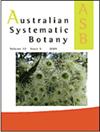地方病区域和环境异质性:以墨西哥豆科植物为例
IF 1.6
3区 生物学
Q4 EVOLUTIONARY BIOLOGY
引用次数: 0
摘要
摘要蚕豆科是一个单系家族,在全世界有22000多种。在墨西哥,它是物种第二多的家族,栖息在多种生态系统中,生命形式高度多样。我们的目的是(1)通过对488种墨西哥豆科植物在不同细胞大小(1°、0.5°和0.25°)下的地方性分析,确定地方病(AE)区域;(2)描述AE的气候和地形异质性,(3)确定AE与气候和地形异质性之间是否存在正相关关系,以及(4)检查定义AE的豆类的保护状况。我们发现了6个一般AE,有63个物种支持,地方性指数值在2.05到6.86之间。这些一般地区有生物地理省份交叉的区域,并表现出更高的环境异质性。在1°处检测到的区域显示出地方性指数与环境异质性之间的正相关。豆类物种目前在墨西哥缺乏法律保护,根据国际自然保护联盟的数据,69%的特有物种没有评估类别,8个物种属于某种风险类别。未来的保护工作应侧重于保护地方性地区,使其不成为具有代表性的自然保护区。本文章由计算机程序翻译,如有差异,请以英文原文为准。
Areas of endemism and environmental heterogeneity: a case study in Mexican legumes
Abstract. Fabaceae is a monophyletic family comprising more than 22 000 species worldwide. In Mexico, it is the second-most species rich family, inhabiting multiple ecosystems with a high diversity of life forms. Our aims were to (1) identify areas of endemism (AEs) by using endemicity analysis at different cell sizes (1°, 0.5° and 0.25°) for 488 Mexican legumes, (2) describe the climatic and topographic heterogeneity of AE, (3) determine whether there is a positive relationship between AEs and climatic and topographic heterogeneity and (4) examine the conservation status of legumes that defined the AEs. We found six general AEs, supported by 63 species, with endemicity index values ranging from 2.05 to 6.86. These general areas had zones where biogeographical provinces intersected and exhibited a higher environmental heterogeneity. Areas detected at 1° showed a positive relationship between endemicity index and environmental heterogeneity. Legume species currently lack legal protection in Mexico, 69% of the endemic species do not have an evaluation category according to the International Union for Conservation of Nature, and eight species are in some risk category. Future conservation efforts should focus on protecting endemism areas from accomplishing representative natural protected areas.
求助全文
通过发布文献求助,成功后即可免费获取论文全文。
去求助
来源期刊

Australian Systematic Botany
生物-进化生物学
CiteScore
3.10
自引率
12.50%
发文量
12
审稿时长
>12 weeks
期刊介绍:
Australian Systematic Botany is an international journal devoted to the systematics, taxonomy, and related aspects of biogeography and evolution of all algae, fungi and plants, including fossils. Descriptive taxonomic papers should normally constitute a comprehensive treatment of a group. Short papers on individual species and nomenclatural papers must contain significant new information of broader interest to be considered. The prestigious L.A.S. Johnson Review Series is published. Other review articles will also be considered. All papers are peer reviewed.
Australian Systematic Botany is published with the endorsement of the Commonwealth Scientific and Industrial Research Organisation (CSIRO) and the Australian Academy of Science.
 求助内容:
求助内容: 应助结果提醒方式:
应助结果提醒方式:


